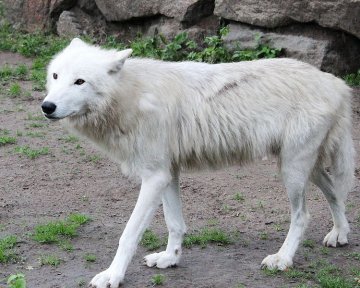Arctic Wolf
The arctic wolf is a smaller breed of the gray wolf. This wolf has much shorter legs and ears and a very thick coat of fur. Its muzzle is also somewhat shorter than that of the gray wolf. Having these differences is what helps the arctic wolf withstand the below zero temperatures and frozen ground. This wolf is usually all white in color with a very thick coat which helps to insulate them from the cold. The arctic wolf is the only species of its kind that can survive in such a frigid climate of -22 degrees Fahrenheit.
Habitat
The arctic wolf lives alone or in a pack of about six to seven other wolves. On rare occasions they live in a group of up to 30. The wolf makes its home in the Arctic along the northernmost boundary of our North American continent and further north to the North Pole. It also lives along the eastern and northern shore of Greenland. Because the ground is always frozen solid the arctic wolf may use rocks, caves or a shallow area in the ground as a den.
Mating
The arctic wolf's breeding period's are from January to February. They reach sexual maturity at two to three years and carry their young for 50 to 60 days before delivery. There are usually no more than 4 or 5 wolf pups in the litter. Wolf pups are born with a solid white coat and dark eyes.
Diet
This wolf is a meat eater and eats Species of oxen that can weigh nearly 1,000 lbs. Another food of choice to the arctic wolf is a Caribou sub-species found in the Arctic Islands of Canada. They will also eat arctic foxes, birds, rodents, seals and hares.
Physical Characteristics
The adult male is usually between twenty-five and thirty one inches tall at the shoulder. At full growth the adult male can weigh 175 pounds. Females are smaller in stature than their male counterparts and weigh about 100 pounds at maturity. From head to tail the female can reach lengths of 5 feet.
Predators and Threats
Humans, other wolves and polar bears are of great danger to the arctic wolf. Because this species of wolf is much smaller than its cousin the gray wolf, it is easy prey for a massive polar bear. One swipe from the polar bear’s paw can quickly become the demise of the wolf. Additionally, dog fights with other wolves can cause serious injury and death. Humans with their misunderstanding and fear of wolves in general can be quick to shoot the wolf. Of these threats humans are the number one killer of this animal.
Lifespan
The lifespan of the arctic wolf is only about 7 years in the wild whereas in captivity the wolf can live up to 20 years and sometimes longer. It faces many hardships such as extremely frigid temperatures, falling prey to other animals or coming across humans who will shoot them.

